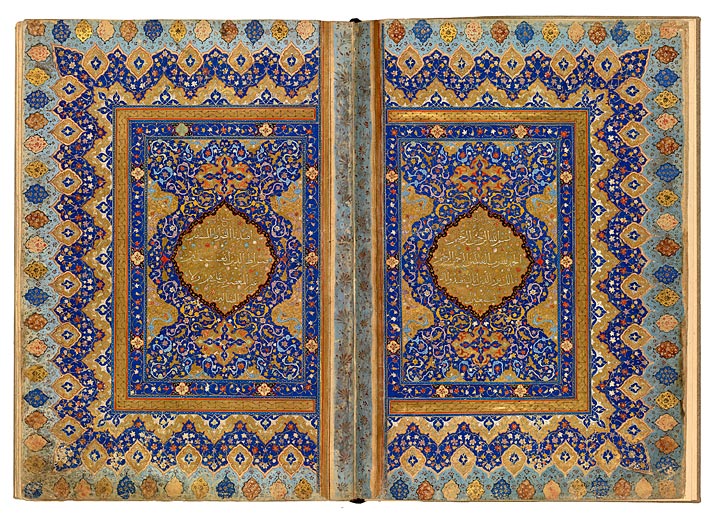
This is the second pair of richly decorated facing pages in the Jerrāḥ Pasha Qur˒an, made in Shiraz about 1580. It marks the beginning of the Qur˒an itself, starting with sura 1 (al-Fātiḥa, or "The Opening Chapter"). The five lines of text on each page are enclosed within a gold-lobed medallion. They are written in raiḥān (sweet basil) script, which was much favored by poets, for its very name evoked its fragrance. Muḥammad Aṣlaḥ, an eighteenth-century poet, even wrote that real gardens would envy the raiḥān twig "lifting its head from the bismillah (call to piety)." The first line contains the title of the sura, followed by the call to piety, the bismillah: In the name of God, the Merciful, the Compassionate. The sura is continued on the left page. Each sura (except the ninth) begins with the bismillah. This double-opening, and the three others in the manuscript, closely resemble the work of the Ottoman master gilder Muḥammad ibn Tāj al-Dīn Ḥaidar (d. 1588).
The Qur˒an, the Holy Book of Islam
From a monumental volume used in an Istanbul mosque to a miniature Persian version that served as a talisman, this section features examples of illuminated pages from the holy book of Islam. The Qur˒an (to recite) represents the codification of the words of God that were revealed and transmitted through the angel Gabriel to the prophet Muḥammad (ca. 570–632) over a period of twenty-three years. The visions began in 610 in a cave on Mount Hira near Mecca, his birthplace, and continued after his 622 flight to Medina, until his death. His flight—the Hijra—marks the beginning of the Islamic calendar.
The revelations were arranged into 114 suras (chapters), each named after its theme. The first and shortest ones, at the end of the book, from the Meccan period, establish Muḥammad as the final prophet in a line of monotheists, including Abraham and Jesus. The longest suras, placed at the beginning, are Medinan and deal more with social and political issues.
For centuries, Qur˒ans were written in Arabic, the language of transmission. After Muḥammad's death, his cousin ˓Alī and others compiled the revelations into a text. About twenty years later, under Uthman, the third caliph (644–656) succeeding Muḥammad, a standard version of the Qur˒an —essentially the one used today—was produced. Thereafter Islam (which means "surrender to God") spread from the Arabian Peninsula throughout the Middle East, to northern Africa and southern Spain, and eventually the world.
